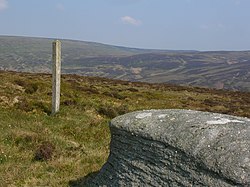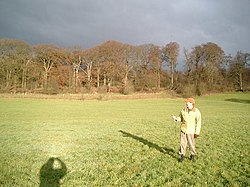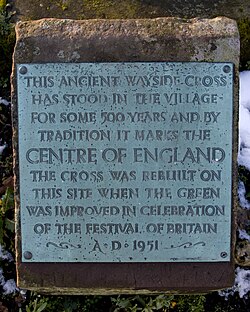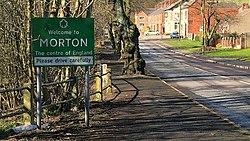Centre points of the United Kingdom


There has long been debate over the exact location of the geographical centre of the United Kingdom, and its constituent partsm due to the complexity and method of the calculation, such as whether to include offshore islands, and the fact that erosion will cause the position to change over time. There are two main methods of calculating this "centre": either as the centroid of the two-dimensional shape made by the country (projected to the Airy ellipsoid then flattened using the Transverse Mercator projection), or as the point farthest from the boundary of the country (either the sea, or, in the case of the constituent parts, a land border). These two methods give quite different answers.
Traditional locations
The town of Haltwhistle in Northumberland has banners stating that it is the "Centre of Britain". By another calculation the centre can also be said to be Dunsop Bridge in the West Riding of Yorkshire), 71 miles to the south.[1]
For centuries the parish of Meriden to the west of Coventry has claimed to be the geographical centre of England, and there has been a stone cross there commemorating the claim for at least 500 years. The justification is that the point farthest from the sea is in the parish. Morton, Derbyshire also claims to be the centre of England as it is not only mid-way along England's longest north-south axis, but also midway between the east coast and the Welsh border. Claims are also made for a tree, the Midland Oak, on the boundary between Lillington and Leamington Spa, Warwickshire, although the basis for these claims is not clear.
However, in 2002 the Ordnance Survey conducted studies that pinpointed the respective centres more precisely, and it is their results that are quoted below.
Centroid locations


The centroid is the point at which a cardboard cut-out of the area could be perfectly balanced on the tip of a pencil. Islands are assumed fixed to the mainland in their precise position by invisible rigid weightless wires. A mathematical method is used to do the balancing to a much greater accuracy than the practical method could achieve.
Unless stated, positions are the centroids of two-dimensional shapes. Calculations include offshore islands unless stated.
Great Britain (including surrounding islands)
- Whitendale Hanging Stones, near Brennand Farm, outside Dunsop Bridge, Yorkshire in the Forest of Bowland.(54°0’13"N, 2°32’52"W; SD6418856541) [1]
Great Britain (excluding islands other than the island of Great Britain itself)
- A field near Whalley, Lancashire (53°49’32"N, 2°25’19"W; SD7232136671)[2]
England (excluding Monmouthshire)
- Lindley Hall Farm, Leicestershire (near Fenny Drayton and Higham on the Hill) (52°33’43"N, 1°27’53"W; SP3637496143) [3] A plaque denoting this point, and disputing the "traditional" centre of England as being at Meriden in Warwickshire, was erected by Ordnance Survey on 14 June 2013 [4]
Northern Ireland
- Annaghone, near Cookstown, Tyrone (54°36’27"N, 6°41’35"W [5] NV9706433729 ) Irish grid ref H 84494 74047.
Scotland
- Between Blair Atholl and Dalwhinnie, Perthshire (56°49’0"N, 4°11’2"W; NN6678471599) [6]
Wales (including Monmouthshire)
United Kingdom of Great Britain and Northern Ireland
- A position "in the middle of Morecambe Bay", approximately a mile and a half off the coast at Morecambe, Lancashire (54°5’36"N, 2°53’41"W; SD4157566760.[8]
Locations found by other methods
Point farthest from the sea
- Church Flatts Farm, Coton in the Elms, Derbyshire[1] (52°43’39"N, 1°37’31"W)
Point farthest from high tide mark (including tidal rivers)
- Between Hammerwich and Wall, south-west of Lichfield, Staffordshire (52°39’36"N, 1°51’0"W;)
Centre of a rectangle enclosing precisely all of England and Wales
- Near Woodseaves, south of Market Drayton, Shropshire
Mid point of the longest north–south axis
- Haltwhistle, Northumberland. The midpoint of the longest north–south meridian; also approximately the midpoint of each of the lines through it across Great Britain along the 16 main compass directions.[9]
See also
Further reading
- John Michell (2009). Sacred Center: the Ancient Art of Locating Sanctuaries. Inner Traditions. ISBN 1594772843.
References
- ↑ 1.0 1.1 1.2 Brady Haran (20 October 2002). "Stuck in the middle with ewe". BBC News. http://news.bbc.co.uk/1/hi/uk/2271914.stm. Retrieved 2 January 2010.
- ↑ "Q. Where is the centre of mainland Great Britain?". MapZone. Ordnance Survey. http://mapzone.ordnancesurvey.co.uk/mapzone/didyouknow/whereis/q_16_35.html. Retrieved 23 November 2011.
- ↑ "A tale of two centres". BBC. 2002-10-22. http://news.bbc.co.uk/1/hi/england/2271925.stm. Retrieved 2010-01-02.
- ↑ "New centre of England marked in Fenny Drayton". BBC. 2013-06-14. http://www.bbc.co.uk/news/uk-england-leicestershire-22901222. Retrieved 2013-06-14.
- ↑ "Meg in the middle". BBC. 2002-10-23. http://news.bbc.co.uk/1/hi/northern_ireland/2350221.stm. Retrieved 2010-01-02.
- ↑ "Brave hearts of Scotland". BBC. 2002-10-24. http://news.bbc.co.uk/1/hi/scotland/2271926.stm. Retrieved 2010-01-02.
- ↑ "Saving the centre of Wales". BBC. 2002-10-24. http://news.bbc.co.uk/1/hi/wales/2271927.stm. Retrieved 2010-01-02.
- ↑ BBC News (calculation made by Ordnance Survey) 16 September 2014
- ↑ The Centre of Britain Template:Wayback, Centre of Britain Hotel, Haltwhistle, Northumberland. Accessed May 2012